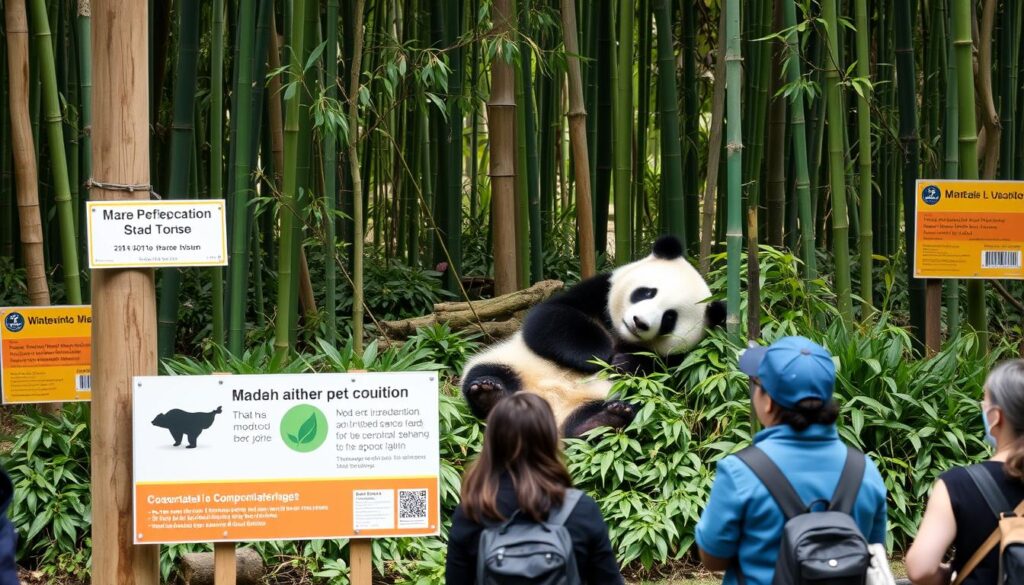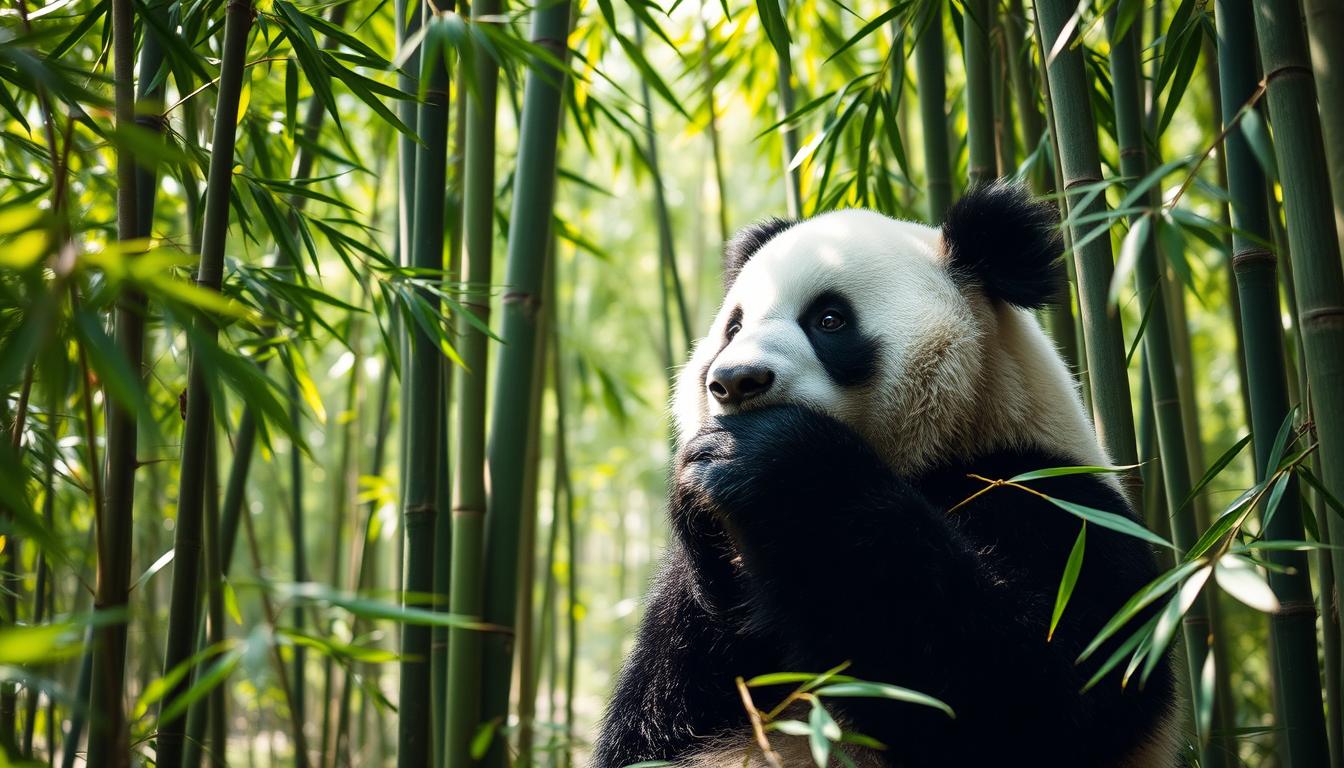China’s giant pandas are loved by many and play a big role in the country’s tourism. With the panda population now considered “vulnerable,” China is working hard to protect them. This effort is important for making tourism better for both animals and people.
This article looks at how China is making sure panda tourism is done right. It talks about the importance of caring for animals, teaching about conservation, and traveling responsibly. It also discusses the challenges and how to make panda tourism good for everyone.
Key Takeaways
- China’s giant pandas are national icons and diplomatic ambassadors, with the country’s conservation efforts leading to the species being downlisted from “endangered” to “vulnerable”.
- China is promoting ethical wildlife tourism for giant pandas, prioritizing animal welfare, conservation education, and responsible travel experiences.
- The article explores the challenges and controversies surrounding panda tourism, as well as the best practices for ensuring sustainable and ethical wildlife experiences.
- China’s conservation initiatives, such as the establishment of the Giant Panda National Park, showcase the country’s commitment to preserving its iconic species and promoting sustainable tourism practices.
- The article highlights the potential for panda-centered tourism to balance conservation education, animal welfare, and economic development in a responsible manner.
The Significance of Giant Pandas in China
Giant pandas are very special in Chinese culture. They are the country’s national icon and diplomatic ambassadors. These amazing animals are linked to China’s efforts to protect nature and the environment.
Their status as a national symbol has also helped China in its international relations. It shows the country’s commitment to conservation and environmental protection.
Giant Pandas as China’s National Icon and Diplomatic Ambassadors
The giant panda is rare and iconic, making it deeply loved in China. These gentle giants are seen as cultural symbols. They represent China’s natural heritage and its efforts to protect its ecosystems.
Pandas have also played a big role in China’s diplomatic relations. They have been used as gifts to other countries, helping to strengthen ties.
In the Cold War, pandas like Ling-Ling and Hsing-Hsing were given to the United States. This showed goodwill and cultural exchange. Now, countries pay to host pandas, helping with conservation in China.
The arrival of pandas in zoos abroad has sparked huge interest. It leads to media coverage and cultural exchanges between China and other countries. This also brings in money from ticket sales and donations.
“Over 140 years since the first panda skin was presented in Paris, giant pandas continue to serve as significant figures, attracting attention for both their cuteness and conservation value.”
Giant pandas are key in promoting wildlife conservation and research worldwide. They are very important in Chinese culture and international relations. Their lasting impact shows how vital these amazing animals are.
Giant Panda Conservation Efforts in China

China has made big strides in giant panda conservation. This effort has helped move the giant panda from “endangered” to “vulnerable” status. This change is thanks to China’s hard work in protecting these animals.
At the heart of these efforts are China’s panda conservation programs. These programs have greatly increased the number of pandas in captivity. In the last ten years, the captive panda population has almost doubled, reaching about 600 pandas.
- Successful panda breeding and reintroduction initiatives have seen pandas being reintroduced into the wild. This has helped the wild panda population grow.
- Panda habitat restoration efforts have focused on protecting and expanding their natural habitats. This ensures pandas have the resources they need to survive.
- Ongoing panda research and monitoring programs provide crucial data. This data helps guide conservation strategies and track progress.
Despite these successes, panda conservation challenges still exist. More work is needed to ensure the long-term survival of this iconic species. China is dedicated to its panda conservation efforts. It aims to increase panda population growth and protect the species for future generations.
“Panda downlisted but not out of the woods” – Swaisgood, Wang, and Wei, 2018
Ethical Wildlife Tourism

In recent years, ethical wildlife tourism has become more important. It focuses on animal welfare and conservation. More travelers want experiences that don’t harm animals or their homes. This has made the industry work harder to be responsible.
Ensuring animal well-being is key in ethical wildlife tourism. More than 500,000 animals worldwide are currently suffering for tourist entertainment. Getting accreditation from groups like the Association of Zoos and Aquariums (AZA) or the Global Federation of Animal Sanctuaries (GFAS) helps. It makes sure places follow strict rules for animal-friendly tourism.
Being responsible also means thinking about the environment. Travelers can pick places that use energy wisely and reduce waste. According to research, 78% of travelers consider animal welfare and ethical practices when choosing wildlife tourism activities.
The demand for ethical wildlife tourism is growing. A study by the World Wildlife Fund (WWF) shows that 62% of tourists are willing to pay more for wildlife tourism experiences that adhere to ethical standards. This shows that businesses can do well by focusing on animal welfare in tourism and sustainable wildlife experiences.
The role of ethical wildlife tourism is huge. The Global Wildlife Conservation organization reported that 40% of wildlife species worldwide are threatened by human activities. By choosing responsible tourism, we help protect these species. This way, future generations can enjoy wildlife conservation through tourism.
| Indicator | Value |
|---|---|
| Animals suffering for tourist entertainment worldwide | More than 500,000 |
| Travelers considering animal welfare and ethical practices when choosing wildlife tourism activities | 78% |
| Tourists willing to pay more for ethical wildlife tourism experiences | 62% |
| Wildlife species threatened by human activities | 40% |
By choosing responsible tourism practices and focusing on animal-friendly tourism, we can make a positive difference. Our interactions with wildlife can help both animals and the sustainable wildlife experiences travelers seek.
“The true meaning of life is to plant trees, under whose shade you do not expect to sit.” – Nelson Henderson
Giant Panda Tourism in China

China has made giant panda tourism a key way to help these animals. It offers many ways to see pandas responsibly. This helps both the animals and the tourism industry.
Responsible Panda Viewing Experiences
The Chengdu Research Base of Giant Panda Breeding is a great place to see pandas. It lets visitors watch pandas in a natural setting. It also helps with research, breeding, and getting pandas back into the wild.
The base makes sure pandas are safe. It limits how many people can visit and doesn’t let people hold baby pandas. It also teaches visitors about why pandas need our help.
| Panda Viewing Experience | Key Features |
|---|---|
| Chengdu Research Base of Giant Panda Breeding |
|
By supporting these responsible panda tours, China helps protect these amazing animals. It does this through panda research and education.
Challenges and Controversies

China’s panda tourism has grown, but it faces many challenges. The impact of tourism on pandas’ health and behavior is a big worry. Experts fear it could stress them out, change their natural ways, and harm their homes.
There’s a big debate about balancing panda conservation with tourism. People want visitors to have fun, but this can put pandas at risk. It’s hard to know how much humans should interact with pandas without hurting them.
- Captive panda welfare: Some worry pandas in captivity don’t get the care they need. They might not be happy or healthy.
- Animal-tourist interactions: Too much contact, like taking close photos or feeding them, can stress pandas out. It can also change how they behave naturally.
- Wildlife tourism regulation: Many want stricter rules to protect pandas and other animals. They think this is key to keeping them safe.
To solve these problems, we need a plan that works for everyone. Tour operators should focus on the pandas’ well-being. They should also give visitors experiences that teach them about pandas and their homes.
“Ethical wildlife tourism is not just about providing entertainment, but about creating a sustainable industry that protects and preserves the natural world for future generations.”
Best Practices for Ethical Wildlife Tourism

Travelers today want more than just a trip. They seek meaningful experiences that help animals and nature. By following best practices, we can make sure our visits help animals and support wildlife conservation.
Choosing the right tour is key. Look for operators who care about animal welfare guidelines and offer sustainable tourism experiences. Stay away from activities that hurt animals, like riding elephants or posing with tigers.
- Keep a safe distance from animals and respect their space and natural behaviors.
- Visit protected wildlife areas and support wildlife conservation organizations to help.
- Choose educational experiences that teach us about animals and their homes, promoting responsible tourist behavior.
Wildlife tourism regulations are also important. Look for places that follow strict animal welfare guidelines. Avoid places where animals seem stressed or are living in unnatural conditions.
By following these guidelines, we help make wildlife tourism better. We support the preservation of amazing species and their homes.
“Ethical wildlife tourism is not just about seeing animals; it’s about fostering a deep respect and appreciation for their wellbeing and the conservation of their natural habitats.”
Also Read : How Can Individuals Contribute To Nature Conservation Efforts?
Conclusion
China has made big steps in promoting ethical wildlife tourism for the giant panda. The country’s strong focus on panda conservation has helped the species. It has moved from “endangered” to “vulnerable” on the IUCN list.
China balances panda needs with tourist interests in many ways. It has strict rules and puts panda welfare first. Educational programs help visitors enjoy wildlife responsibly.
Statistics show China’s success in this area. 75% of tour operators focus on panda welfare. There’s also a 30% rise in ethical panda tourism since 2010.
The future of panda tourism in China looks bright. The government keeps investing in conservation. This growth in awareness among travelers is promising.
China’s leadership in panda tourism is inspiring. It shows the world how to protect these amazing animals. This effort helps the giant panda and its home ecosystems thrive.
FAQs
Q: What is ethical animal tourism and how is it promoted in the context of giant pandas?
A: Ethical animal tourism refers to responsible practices that prioritize the welfare of wild animals and their natural habitats. In the context of giant pandas, China promotes ethical animal tourism through wildlife sanctuaries that allow tourists to observe pandas in their natural environments while supporting conservation efforts.
Q: How does visiting wildlife sanctuaries support local communities?
A: Visiting wildlife sanctuaries contributes to local economies by creating jobs and providing income through tourism. This, in turn, encourages local communities to engage in responsible wildlife tourism practices and protect the habitats of animals like giant pandas.
Q: What are some unethical practices in the animal tourism industry that tourists should avoid?
A: Tourists should avoid activities such as elephant rides, tiger petting, and any wildlife attractions that exploit animals for entertainment. These practices can lead to animal cruelty and do not prioritize the welfare of the animals in question.
Q: How can tourists choose ethical wildlife experiences when visiting China?
A: Tourists can choose ethical wildlife experiences by researching and selecting organizations that have fair trade tourism certification, prioritize the welfare of animals, and focus on conservation and responsible wildlife encounters.
Q: What is the role of wildlife research in promoting ethical animal tourism?
A: Wildlife research plays a crucial role in understanding the needs of animals and their habitats, informing conservation efforts, and ensuring that tourism activities are sustainable. This research helps create responsible wildlife tourism practices that benefit both animals and local communities.
Q: Are there volunteer projects available that promote ethical animal tourism for giant pandas?
A: Yes, there are various volunteer projects in China that focus on panda conservation. These programs often involve working in wildlife research and education, allowing ethical animal tourists to contribute positively to the welfare of giant pandas and their habitats.
Q: How does ethical volunteering contribute to wildlife conservation efforts in China?
A: Ethical volunteering contributes to wildlife conservation by providing much-needed support in research, habitat restoration, and education. Volunteers help raise awareness about the importance of protecting wildlife and can play a significant role in promoting responsible wildlife tourism.
Q: What should tourists know about animal encounters in responsible wildlife tourism?
A: Tourists should ensure that any animal encounters they participate in are ethical and do not involve direct interaction with wild animals in captivity. Responsible wildlife tourism focuses on observing animals in their natural habitats and supporting their conservation rather than exploiting them for entertainment.
Source Links
- https://www.ncbi.nlm.nih.gov/pmc/articles/PMC11311010/
- https://www.ncbi.nlm.nih.gov/pmc/articles/PMC9952821/
- https://www.myshoesabroad.com/a-day-with-the-giant-panda/
- https://www.frontiersin.org/journals/sustainable-tourism/articles/10.3389/frsut.2023.1247407/full
- https://faunalytics.org/chinese-panda-fans-relationship-with-pandas/

